Discover the Wonders of Tide-Pooling on Oregon’s Adventure Coast
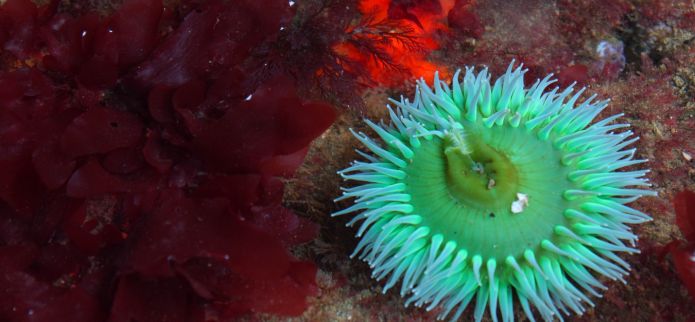
A Handy Guide to Exploring Marine Life in Coos Bay, North Bend, and Charleston
With its rugged shores and extraordinary biodiversity, Oregon’s Adventure Coast: Coos Bay, North Bend, and Charleston is a treasure trove for anyone fascinated by marine ecosystems. This spring and summer, explorers of all ages are invited to uncover the wonders of the tide pools scattered along our undeveloped beaches and state parks .
Curious visitors can often spot marine creatures such as limpets and chitons clinging to rocks, vibrant sea slugs (nudibranchs), and sea stars populating these unique habitats. Want to learn more about tide-pooling on Oregon’s Adventure Coast ? Keep reading for answers to some of the most frequently asked questions!
Please be sure to follow these beach safety guidelines and treat the area with care. These are living plants and animals in their natural environment.
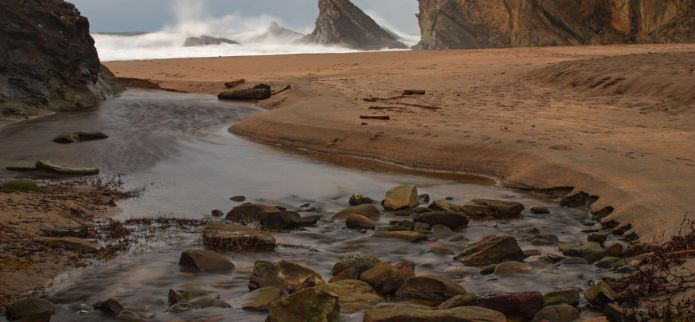
What Is Tide-Pooling? Tide-pooling is the activity of exploring shallow pockets of seawater left behind among rocky shorelines when the tide recedes. These small pools offer an exciting glimpse into marine life, where you might encounter entire ecosystems with living, breathing organisms. Always remember to explore gently, avoid disturbing or removing any plants or animals, and tread carefully to protect these delicate habitats.
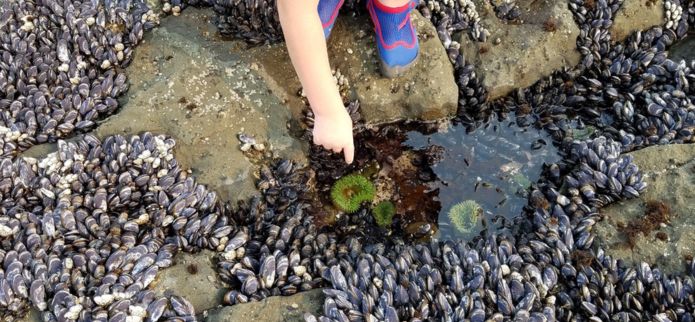
What Makes Tide-Pooling on Oregon’s Adventure Coast So Special? Tide-pooling is especially popular along the Oregon Coast because these rocky shorelines are home to some of the most biodiverse intertidal habitats on the planet. This is particularly true on Oregon’s Adventure Coast: Coos Bay, North Bend, and Charleston , where rugged terrain, sandy beaches, bays, estuaries, hidden coves, sea caves, expansive sand dunes, and the vast Pacific Ocean come together to create the perfect environment for marine life to thrive. If you’re looking for a tide-pooling experience that’s both rich in biodiversity and ideal for families or small groups, you won’t find a better destination.
Will I Need Special Equipment or Skills to Go Tide-Pooling? No special equipment or skills are required. All you need is a good pair of sturdy, non-slip shoes, a warm jacket in case of cool weather, a sharp eye for spotting marine life, and a sense of curiosity. Knowing when and where to look, usually at low tide in rocky coastal areas, will help you make the most of your visit.
Is Tide-Pooling the Same Thing as Beachcombing? No, they’re not the same, though they do share some similarities. Both activities usually take place near the water at low tide and require little to no special equipment or training. Beachcombing is the search for non-living items or washed-up treasures such as driftwood, shells, agates, sea glass, kelp, feathers, and occasionally marine debris. Tide-pooling, on the other hand, involves discovering and observing living marine organisms in their natural intertidal habitats. Think of tide-pooling as visiting a miniature marine zoo, while beachcombing is more like going on a coastal treasure hunt. Both are rewarding in different ways.
When Is The Best Time To Go Tide-Pooling? The best time to go tide-pooling on Oregon’s Adventure Coast is during low tide, particularly in the spring and summer months when minus tides (tides below 0.0 feet) expose the greatest stretch of intertidal habitat. These minus tides, usually occurring a few times each month around the full or new moon, reveal hidden marine life and rock formations that are otherwise submerged, making them ideal for tide-pooling and beachcombing.
Morning low tides are best, as daylight aligns with the lowest tide levels, and marine experts recommend arriving one to two hours before the posted low tide to explore safely as the water recedes. Always check local tide charts (such as tides4fishing.com ,tideschart.com ) for the most accurate timing in the Coos Bay area.
What Should I Wear? Wear sturdy shoes or boots with a good grip. Tide-pooling often involves walking on wet rocks, uneven surfaces, and slippery seaweed, so footwear with traction is essential for both safety and comfort. Avoid flip-flops or open-toed sandals—closed-toe shoes will help protect your feet from sharp rocks, barnacles, and other hazards commonly found along the shore. Dress in layers and bring a waterproof jacket, especially on cooler or windy days.
What Am I Looking for When Tide-Pooling on Oregon’s Adventure Coast? Tide-pooling on Oregon’s Adventure Coast is like stepping into a miniature marine world, full of fascinating life revealed by the rhythm of the tides. In the high intertidal zone, look for acorn barnacles , limpets , periwinkle , and black turban snails , along with seaweeds like rockweed and sea lettuce . In the mid-zone, you might spot mussels , colorful sea anemones , hermit crabs , chitons , and sponges .
During minus tides, the low intertidal zone reveals purple sea stars , sea urchins tucked in crevices, nudibranchs (colorful sea slugs), and small tidepool fish like sculpins . Keep an eye out for shorebirds like gulls and oystercatchers and harbor seals resting nearby. Just be sure to tread gently and leave everything as you found it.
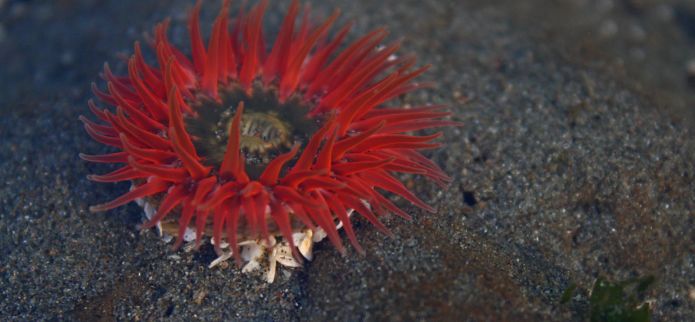
Is Tide-Pooling Safe? Tide-pooling is generally a safe and family-friendly activity, but like any adventure near the ocean, it comes with risks. To stay safe, always check the weather and ocean conditions before heading out. Avoid visiting during storms or high surf, and Never Turn Your Back on the Ocean. Sneaker waves can appear without warning and reach farther up the beach than expected.
Plan your visit during low tide, and go with a buddy, especially in remote areas. Wear sturdy, non-slip shoes (never go barefoot), as rocks and surfaces can be sharp or slippery with seaweed. Tread carefully to avoid falls and to protect the marine life underfoot.
Stay on marked paths, observe all posted signs, and keep a close eye on children. Teach them to respect the tidepools and the creatures living in them. And finally, always stay away from cliffs, logs, and rough shore breaks; these can pose serious hazards even on calm days. For more safety guidance, follow these beach safety tips .
Where Are the Best Places to Go Tide-Pooling on Oregon’s Adventure Coast? Oregon State Parks situated on the Oregon Coast are among the best destinations to explore tide pools, according to Tiffany Boothe of Seaside Aquarium in this Oregon Coast Beach Connection article. “State parks are easier to access, safer, and more frequently visited. That’s a plus—not a minus,” she says. “And most importantly, they’re the most beautiful.” Oregon State Parks are known for their commitment to environmental stewardship and visitor safety.
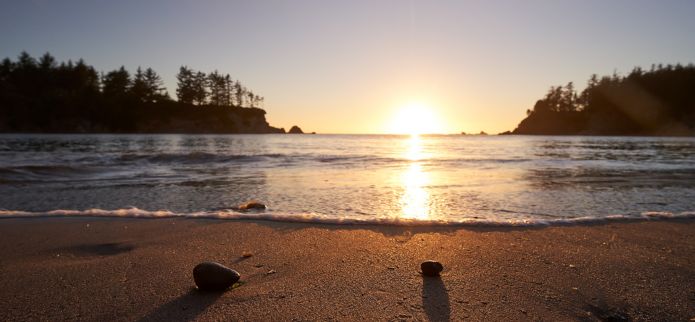
One of the best ways to experience tide-pooling on Oregon’s Adventure Coast is by exploring the Cape Arago Loop in Charleston, which connects three outstanding Oregon State Parks.
- Sunset Bay State Park – Family-friendly with easy access, sandy beaches, campgrounds, restrooms, and fantastic tide pools framed by towering sea cliffs.
- Shore Acres State Park – Known for dramatic ocean views and botanical gardens, with a trail leading down to Simpson Beach, a secluded cove with rich tide pools and regular sightings of seals, sea lions, and whales.
- Cape Arago State Park – Offers rugged coastal trails to secluded coves filled with sea life. The south trail leads to vibrant tide pools, while the north trail (closed March–June to protect seal pups) offers views of offshore seal and sea lion colonies.
Additional noteworthy tide-pooling spots include:
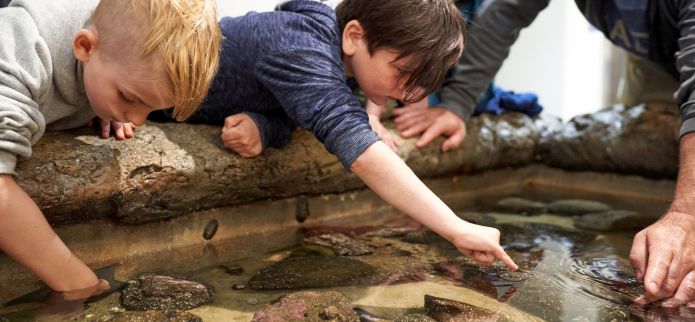
- Charleston Marine Life Center (CMLC) – Located in Charleston, this indoor facility features a touch tank where visitors can interact with sea stars, urchins, and other tide-pool species. It’s a great alternative during bad weather or for those with mobility concerns.
- Bastendorff Beach – Less crowded and popular among locals, surfers, and beachcombers. Defined by Yoakam Head and the south jetty, it’s a great spot for scenic views and beach walks.
- Yoakam Point State Natural Site – A more rugged and undeveloped area with beautiful views and tide pools accessible at low tide. Note: the trail down is steep and can be slippery, so it’s best for experienced explorers.
For Complete Details, Download our PDF Guide for the Cape Arago Beach Loop.
Other Things to Remember

No matter where or when you go, remember to check the tide charts before your trip and practice responsible tide-pooling etiquette to preserve these delicate coastal ecosystems for future generations.
- Take only memories, not marine life – Tide-pooling is not the same as beachcombing. Please don’t collect anything—living or dead. Leave shells, animals, and rocks where you find them.
- Leave it better than you found it – Bring a small bag to collect your trash—and feel free to pick up any litter you see. Every small effort helps protect the coast for others.
- Follow “Leave No Trace
” principles – Be mindful of your impact. Stick to trails, pack out what you pack in, and avoid disturbing wildlife or habitats.
- Keep your distance from wildlife – If you see a seal pup or other animal, enjoy the moment from afar. Do not touch, approach, or feed wild creatures—they’re safest when left undisturbed.
- Watch your step – Walk only on bare rock or sand. Many organisms live on or under rocks and shells, and stepping on them can cause harm.
- Don’t remove attached animals – Never pry limpets, anemones, chitons, or barnacles from rocks. They won’t survive removal. Touch gently with a wet finger, and always return things exactly as you found them.
- Don’t overturn rocks – If you lift a rock to peek beneath, place it back carefully in its original position. Many tide pool creatures rely on the shelter rocks provide for survival.
- Take photos, not souvenirs – A good photo will last longer than a shell in your pocket—and it helps preserve the ecosystem for the next explorer.
Want more ideas? Be sure to follow us on Facebook , Instagram , and TikTok and subscribe to our e-newsletter for travel ideas and inspiration on Oregon’s Adventure Coast, delivered right to your inbox! For more travel inspiration, request a free visitor’s packet and visit our Adventures page & Trip Ideas page to discover all there is to do on Oregon’s Adventure Coast!
